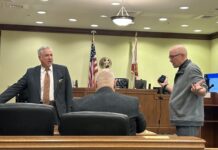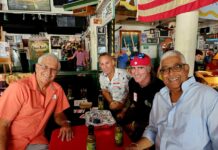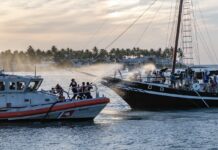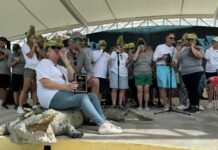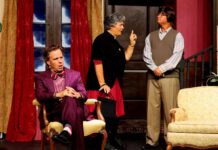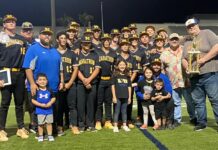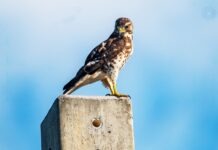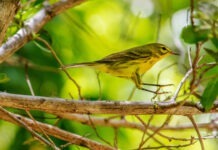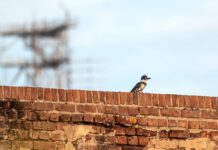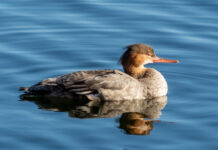At the party, according to Henry A. Patterson, there had been lots of “dancing, eating, drinking, conversing.” There were just enough women there, he said, to form three cotillions, which meant 12 men and 12 women. But then the ladies started drifting out of the room, and they were left with an excess of men, who carried on, forming an all-male cotillion where, he said, “We enjoyed ourselves as well as when we had partners of the fair sex.”
Before they quit, he said, “some of our party got a little intoxicated, rude & boisterous & some dissatisfaction was created among the more orderly sets.”
Words were said, displeasures expressed.
“I avoided all difficulties of that nature; & studiously abstaining from the indulgence of any angry feeling; went to bed in good humour with myself & every one else.”
The next morning he went saltwater fishing with William Hackley for the first time and caught, “some fifty or sixty grouper; yellow tails, & grunts.”
This was in late February 1843.
A few days later he sailed on a borrowed boat up to “Boka Chica” with his friend Alexander to go hunting. They were hoping to shoot some ducks, raccoons, or maybe even Key deer.
“But after spending an hour tramping through the water, mud & bushes, getting miserably bitten by innumerable musquitoes (sic); & finding no signs of game save occasionally a deer track, we got under weigh at five o clock, & beat up home again in four hours; thoroughly drenched with salt water, tired, & hungry. The game had all been driven from the island by two men who had been there shortly before us with dogs,” he wrote.
“On our return we saw a flock of flamingoes, some twenty or thirty in number; & endeavoured to get within shot of them as they stood in the water; but they took to flight too soon for us. The most awkward birds I ever before saw, are perfect specimens of grace & elegance compared with the appearance of these as they flew past us, their long necks stuck straight out before, & their equally long legs trailing behind. But their red & black plumage is said to excel in beauty all the feathered tribe,” wrote Patterson.
“Henry A. Patterson was a New Yorker who worked for a hardware company. And a fella in Key West had gotten into arrears on his accounts for the hardware business,” said Corey Malcom, lead historian at the Florida Keys History Center inside the Key West library. “And so Patterson was sent down here to make things right. And he spent three, four months here, and kept a diary, a detailed account of his whole time.”
“He was the nephew of Alexander Patterson, who was one of the big guys in early 19th century Key West. So he came down, stayed with his uncles and the family here, hung out with them, made things right as far as the debt went. He just had all sorts of crazy Keys adventures, and he wrote about it,” Malcom said.
We know about Patterson’s activities largely due to a cross-generational tag team of Key West historians. Betty Bruce, the original historian at the library, acquired microfilm of the journals in the 1960s from the New York Historical Society. But the film was seriously underexposed, and the pages of the journal were torn in half down the middle. With the technology of the time, the journal was mostly unreadable and sat in a drawer for decades.
Malcom found the microfilm in the drawer, scanned it, used Photoshop to both lighten the handwritten pages and reassemble them, and has been working in recent months to transcribe them. (The Florida Keys History Center will be posting the full set of Keys entries this summer.)
It was the flamingo part that got my attention when a library source told me about the journals. The image of a flock of 20 to 30 American flamingos in the waters between Key West and Boca Chica is, to me, beyond cool. But it also has scientific and environmental value beyond the historical significance.
Until several years ago, the state of Florida did not consider the American flamingo as a native Florida species, despite them being spotted here with some frequency. There was a belief that any flamingo seen in the wild in Florida had either escaped a zoo, Gulfstream race track in Miami, or an aviary. It took a team of biologists from organizations such as Zoo Miami, Florida Audubon and Big Cypress National Preserve to convince them otherwise, which they did by finding historical accounts, such as Patterson’s, as well as finding specimens of birds and eggs collected in Florida in a number of natural history museums.
“We don’t have a lot of records from before, like, 1860. The records are very rare, so this is a really cool observation,” said Steven Whitfield, conservation and research specialist at Zoo Miami, who was one of the co-authors of a paper that convinced the state to consider the American flamingo a native Florida species.
“I loved this record because it’s from a time period where we don’t have many reports. And always with these flamingo records, I’m worried if they’re actually seeing roseate spoonbills, but the way this guy describes the flamingos, it’s absolutely clear it’s flamingos and not spoonbills,” Whitfield said.
“It’s important that he says that he tried to shoot at them. Because it’s kind of unthinkable to shoot a flamingo these days, but the reason they’re not here any more is because people ate them all, and shot them for their feathers. So that’s a really important part of this as well,” Whitfield said.
“These old records give us a really good baseline for what we’d like to manage today. Knowing where flamingos were, how many they were, is really important for establishing recovery targets,” said Whitfield.
